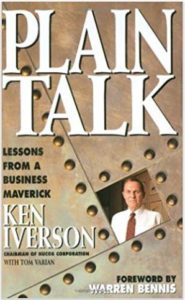The Simplicity of the Amazon Way
14 Principles of Leadership Determine it All for Amazon
Extras…

Elevating Operators. Sharpening Leaders. Strategic frameworks for thriving in finance, leadership, and life.

There are nine principles of management that Ken Iverson holds himself to. These nine areas of focus helped him build a strong and long-term oriented company at Nucor:
1. Establish a higher cause
2. Empower your employees to trust their instincts
3. Destroy the hierarchy
4. Employees are the engine of progress
5. Give your people a stake in the business
6. Stay small
7. Take smart risk
8. Ethics > Politics
9. Cash performance = long-term survival
Establish a higher cause within your organization that employees and managers can rally around.
Give your employees a consistent set of tools that will empower them to trust their instincts and intuition.

Destroy the hierarchy and focus on establishing an egalitarian business culture that can sustain employee motivation.

Dedicate your management career to creating an environment in which employees can stretch for higher levels of performance because they are the true engines of progress.

Place ethics over politics… simple enough
What really matters in a business is bottom-line performance and long-term survival. Focus your efforts there.
Purpose of this article: to explain why the Limited Liability Company (LLC) business format is the best for most small business owners
By default, most businesses end up getting set up as a sole proprietorship. And while the benefits of a sole proprietorship like ease of formation are there, the disadvantages far outweigh these benefits. Specifically, as a sole proprietorship, you bear significant liability risk to your personal assets and from a tax perspective, you are not optimized. The rest of this document will walk you through my recommendation to set your business up as an LLC.
The main disadvantage of a sole proprietorship as a business format is in regards to liability. As the owner of the sole proprietorship you are PERSONALLY LIABLE for all debts and actions of your business. No matter what you do, this business form links all personal wealth to the business. And this liability is unlimited in nature which means creditors can come after all of your personal assets to satisfy your outstanding debts
On top of this unlimited personal liability, the sole proprietorship isn’t as tax advantaged as some of the other business forms. Specifically, at net income generated by your business is subjected to the 15.3% SECA tax (self-employment tax). You then list your remaining net income on your personal income tax on Form 1040 Schedule C and this net income is subjected to your personal income tax rate.
Lastly, because of this business form, it is very difficult for you to raise longer-term capital since you are unable to sell interests or shares in your business. Investors like tax advantaged investment vehicles, and the sole proprietorship isn’t one of them
Given the disadvantages of the sole proprietorship, my recommendation would be for you to consider an single-member managed LLC for your business format. An LLC business format is sort of a hybrid between the partnership and the corporate business forms. The LLC allows the liability protection of a corporation with the tax advantages of a partnership. Once you set up your LLC, it is considered a separate business entity that is owned by investors known as members. In your case, your LLC would be a single-member owned (which is you), and is managed by you as well.
Especially when compared to the sole proprietorship, the LLC limits the liability of the member to the amount of their investment in the LLC. Therefore, a member of an LLC is not personally liable for the debts of the LLC. Under the sole proprietorship business format as I mentioned before, the sole proprietor is liable for all debts incurred by the business. In essence, creditors can go after your home, car, and other personal property to satisfy debts. Hence it’s imperative as a small business owner to at least form an LLC in the minimum. In general, the biggest reason you want to go with an LLC is the tax benefit you get due to the pass through nature of the income generated in the business with the liability protection of the business form.
As mentioned before, the biggest tax benefit of forming an LLC is the pass through nature of the income generated in your business. When structured properly, the income from your LLC is taxed direction to the members at their own personal tax rates.
But there is an even more optimal way to streamline and potentially reduce your business tax liability even further as an LLC. The IRS allows LLC that have been formed to be treated as an S-Corporation for tax filing purposes.
The reason an LLC would want to file as an S-Corporation would be to avoid the 15.3% Self-Employment Tax that is charged on LLC for all income generated. Put another way, the S-Corporation is the only business form that makes it possible for you as the owner of your business to save on Social Security and Medicare taxes.
Below, I give you a tangible business example:

Under this hypothetical scenario where you drive $100,000 in net income and pay yourself a $50,000 wage you would be better off by 24% under the S-Corporation. Please note that there are some major assumptions regarding your wage and effective tax rate, but the argument is the same regardless of the actual numbers.
Filing as an S-Corporation will allow you to avoid the additional tax that is levied on LLC for Social Security and Medicare. But before we get here, let’s get you set up as an LLC first!
In order to get your LLC off the group, you will need to complete the following:
– Talk with Blue Elephant Financial Services.
– Decide on a name for your business.
– Find a business address. Typically I recommend to my clients to go to the UPS store and rent a PO Box. Most states will allow you to use this as your business address. This can run you anywhere from $100 to $200 annually.
– Double check that your business name isn’t already registered with another person and is available in your state. Note that your name will need to contain LLC at the end. Click here for South Carolina and here for North Carolina.
– Verify that the URL and domain name of your company is available. Even if you don’t plan on making a website right this moment, you will want to buy the domain name in order to prevent others from acquiring it. Personally, NorthLake Digital LLC is one of my favorite companies for this task.
– Find a registered agent. I typically advise using a digital option like MyLLC.com. This will cost you around $99 annually. Click here for a direct link to this company.
– File the Articles of Incorporation with your state. North Carolina will cost $125 and South Carolina will cost $110.
– Draft an LLC Operating Agreement. In some states this is required and in others it is option. Regardless this is good practice because this document outlines the ownership and operating procedures of your LLC.
– Register your business with the IRS to get an EIN tax ID number which will be used for tax filling needs. Click here for direct link.
– Apply for a new business bank account that is separate from your personal account. This will force you to separate personal assets from the LLC.
– Consider getting a business credit card. This too will force you to separate personal expenses from the LLC.
– Apply for any pertinent business licenses or permits (depends on your services)
– Complete your annual report (necessary in North Carolina and not necessary in South Carolina) and report your LLC business income on Form 1065 Partnership Return.
In closing, establishing your business as an LLC will help reduce any personal liabilities and will give you the longer-term potential tax benefit (if we file your tax returns as an LLC filing as S-Corporation). My hope in writing this article is that after reading this, you will take the steps to create your own business using the LLC format. I wish you the best of luck in getting your business off the ground and look forward to hopefully serving your needs in a much deeper capacity than just this article.